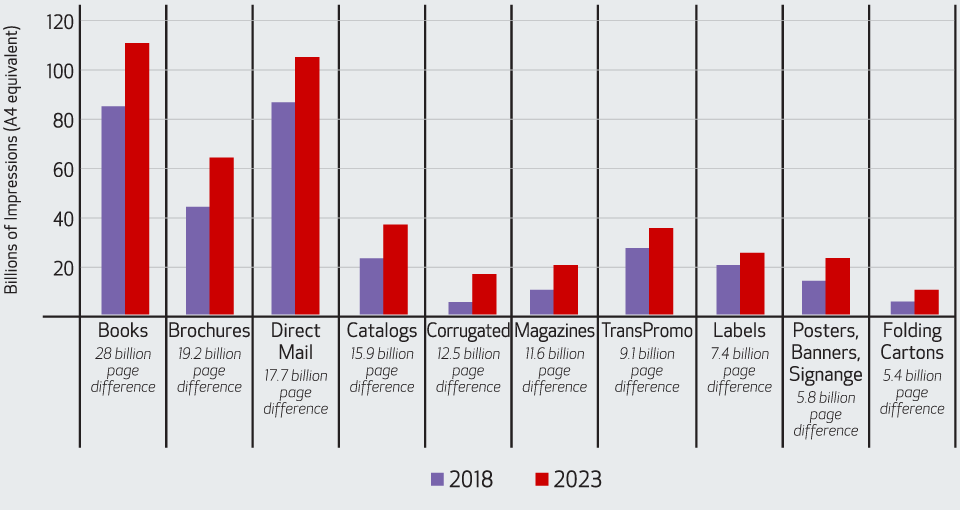2020 Outlook for Book Printers and Publishers: The Future is Here!
Advancements within the on-demand book printing market since its earliest days have given way to a new level of technology that has proven to refine the process of book creation. Content can now move fluidly between electronic and print delivery in a way never before possible.
As proof, adoption and implementation of digital printing presses continue to grow year over year. With this increased productivity, book printers are forced to look at their business priorities differently. Well-prepared print service providers (PSPs) will prioritize filling the capacity created by the efficiencies of their new presses, leveraging the entire supply chain to accelerate growth, and improving the effectiveness of print applications. With these goals in mind, here are some tips and trends for PSPs from Keypoint Intelligence?–InfoTrends’ “Road Map 2020: Business Development Strategies for Print Service Providers.”
It’s Time to Address the Capacity Gap
While it’s very common for PSPs to invest in technologies to meet the evolving needs of publishers and readers alike, this can often lead to a predictable dilemma—book printers are discovering that new and more productive digital presses bring new capacity. When addressed properly, increased capacity typically generates new and often overlooked growth opportunities. Identifying the applications that complement your book production is the first step to filling that gap. Next, ensure your sales team is on the hunt for new opportunities that complement your current capabilities. Once your sales team understands where to look and how to sell to these new opportunities, your new digital press will immediately become a sound investment. Understand that the capabilities built to enable book printing create other opportunities for book-like bound documents such as annual reports, catalogs, directories, and magazines.
Sell the Supply Chain, Not Products
Today’s PSPs often think about their growth in terms of new products and services they can conceptualize, produce, and deliver. Successful PSPs take it one step further and examine where they can optimize their prospects’ and customers’ supply chains. This requires a keen understanding of all the individual contributors and businesses supporting the customer’s operation. Think about how your offerings will be used, then take a step back and consider the many supply chain issues that plague book manufacturing (e.g., inefficient logistics, excessive inventory levels). Identify areas where can you help your clients gain efficiencies and reduce operational costs throughout the workflow. For those not already involved in selling digital print services to publishers, considering the current product offering is the first step. Prepress and printing may be part of existing offerings, but other capabilities (e.g., page scanning or e-book conversion) might not. Examine the entire supply chain—from premedia through inventory and e-commerce—and map out where you might be missing an opportunity to support your customers.
Books to Lead the Digital Printing Platform
In terms of pure pages, the book market is expected to show the biggest gain among digital printing applications. Also expect book page volumes to experience a growth rate of more than 10 percent during the forecast period, representing roughly 55 billion pages by 2023. As shown in the figure below, color page volumes are a major contributor to this growth. Although many book pages are still printed only in monochrome, advancements in digital print technology are making it more attractive to print color content with digital systems. At the same time, however, monochrome pages represent another growth area for books, as production digital print is capturing more pages traditionally printed with offset presses. This is largely due to the productivity and costs of inkjet printing systems making it increasingly attractive to move book block production from offset to digital. Production digital print also ushers in a range of other advantages, including cost-effective short-run printing, just-in-time fulfillment, and the ability to print copies of books on-demand (i.e., when orders have come in). Since production digital printing systems can draw from archives of electronic content on-demand, they can serve as virtual document repositories in a way traditional printing presses cannot.
Fastest Growing Applications by Absolute Page Volume
Source: U.S. Digital Production Printing Application Forecast 2018–2023, Keypoint Intelligence–InfoTrends.
Invest in Smart Print Manufacturing
Continuous improvements in the manufacturing process are a mainstay for profitable growth within book manufacturing organizations. Automation, lean manufacturing, and process improvements help ensure the delivery of the seamless publishing solutions customers demand. The production of short runs and small batches requires particular attention be paid to job onboarding, preflighting, queuing, and support for e-commerce transactions. Without these capabilities, it is impossible to create a highly automated production environment. Sound workflow practices in 2020 will propel firms into the future and prepare them for business growth.
2020 Will Unveil What Was Once the Future
Book printers must continue to focus on business processes and practices to capture growth. As a drupa year, 2020 will undoubtedly deliver many new insights and opportunities. The industry continues to evolve, as does the role of print service providers. Moving forward, adopting new disciplines to deliver relevant communications to the customers’ audience can be the difference between survival and growth. Download Keypoint Intelligence?–InfoTrends’ full 2020 Road Map white paper to learn more about the strategies that can enable you to make better business decisions, craft strategies, and implement plans to innovate your operations throughout the year.
READ THE WHITE PAPER

